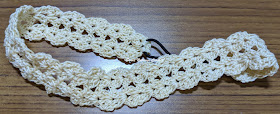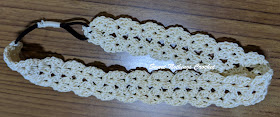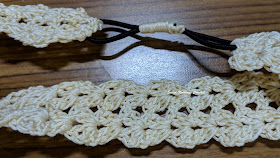AN EASY HEADBAND 2
Quickly on the heels of the easy headband from a few days back, let’s whip up another cute easy one today, shall we? Come along and let’s have some fun
Thank you for joining me.
In case you have just joined me, know that you can access all of my earlier creations by checking under ‘categories’ on the right hand side of this blog under “Labels”. Then, for your convenience, follow me here or on Facebook, You Tube, Pinterest, Twitter or Instagram.
Check out all my social media handles at the bottom of this blog
Oh, and may I add that the fastest way to find any of my blogs is via Pinterest.
All my blogs can be printed. Find the printer friendly (green) link on the right hand side of this blog. You can also hit Control P (or Command P for Mac) on your keyboard, and the blog will go directly to the connected printer.
Remember that you only print if absolutely essential. Save paper – Save Our Earth.
Do remember to add my blog URL when you make and show off your creation.
Just copy the link on the search bar above - that's the blog URL.
To purchase this or similar yarn online, click here to buy your yarns online via Amazon. While you will still pay the same, I may get paid by Amazon as well.
This is a free blog - so do pay it forward for me. Cheers.
Materials used : Today I’ve used some (Indian) Anchor knitting cotton with a 1.75 mm crochet hook
General yarn info : The yarn used today is not specific to this pattern.
You can use any yarn with a suitable hook to make this project to any size.
International yarns : Among the international yarns I have used in this thickness, I’d suggest Aunt Lydia Cotton 10, Aunt Lydia Bamboo-Viscose 10, DMC Petra, Sullivans knitting cotton (Australia), Milford Soft, Hilaza Rustica Eclat , Alize cotton yarn and Alize bamboo yarn.
Difficulty level : Easy
Stitches used :
Single Crochet : Sc : yo, insert hk into st ; yo (2 lps on hk); yo, draw through both lps. One sc made. Check out the video at https://youtu.be/ghACqBpA-3k
Half Double Crochet : Hdc : yo, insert hk into st ; yo (3 lps on hk) ;
yo, draw through all 3 lps. One hdc made.
Chainless start for Half Double Crochet : I dislike the ch-2 start, and this is what I do to start my row of hdc. Check out the video at https://youtu.be/lWXpl1KdbZ8 Here is a sizing chart for general head sizing :
Invisible join : Here’s a quick tutorial on how to join using the embroidery needle and whipstitch to get an invisible join at
https://youtu.be/a6XZQ6VzJFM
Abbreviations used :
sc : single crochet dc : Double crochet
ch : chain ch-sp : chain space
sp : space rep : Repeat
hk : hook lp (s) : loop(s)
yo : yarn over sl-st : slip stitch
Instructions using U.S terminology
The other day I made the easy headband working with a thicker Nako Saten acrylic yarn as well as this Anchor knitting cotton – so go ahead and try it with different thicknesses of yarns to get different stunning results.
Once again for today’s headband we work across the width of the headband.
So while working side to side each row, we’re just working the width and each row will add to the height or length of the headband.
We start at one end working with “V” sts and work along the length till we reach the end. Easy enough, huh?
Please read through till the end of this blog for different ideas for this pattern as well as creating it into a headband or belt.
Today we will use a “V” st which is (2 dc , ch 1 , 2 dc) all in the same st.
For our pattern today we will work 2 “V”-sts together.
Rep Row 2 till you have the length needed for your project.
When you reach the end, you could opt to work 2 sc in each ch-1 sp and finish off. You will then have ended with 4 sts which will match the 4 sts at the start and be an equal join.
Fasten off and weave in ends.
Now that’s the pattern and here’s what you can do with it to make it into a headband.
1) You can start just as is given above and work all the way to the end, making a tape lace. When you get the length needed (which is the circumference of the head of the person you are making it for – and if you do not know the head size, check the chart given above at the start of this blog), you just fold it in half, join the ends and you have a headband ready to go.
2) Or you do not join ends, but add in a button to not only make it seem a bit different but also for convenience. The show button can stand on one side of the head and make the whole creation look oh, so different.
3) Or you start by attaching a rubber band and then work the “V”-st pattern for the length (minus the stretch or length of the elastic rubber band) and then attach your lace to the other end of the rubber band. This way the rubber band is neatly secured and will be at the bottom of the head. The advantage here is that it stretches nicely and fits around the baby’s head without a fuss. Of course, this also means that this headband will be usable for longer (and for an older child as well) thanks to the stretch. The difficulty here is that you need to figure the stretch of the rubber band, and reduce that much in the length. The elasticity of the rubber band will cover for the rest of the ‘length’. Ensure that you get a good rubber band, and one that is ‘coated’ or ‘covered’ (not the plain rubber band that may catch the young girls short hairs on the nape of her head).
4) I’d said we can make this into a belt too – and here’s how. Now instead of adding the rubber band to start, go ahead and add your belt buckle. Then go ahead and follow the pattern all the way to the end, ensuring that you add about 6” more than your round waist measurement. The other end has 2 “V”-sts that may not go through easily through your belt buckle – so if you first finish it off with a set of sc and then I’d suggest you work a sc/hdc or dc-4 tog to hold all four stitches together and get a closed finish and a pointed (of sorts) end that you can feed through your buckle easily. This is an optional finish – if you can feed it through without struggling with a 4-tog finish .. Great! Of course for a belt, you need to add in a small loop that you can feed the free belt end into – but then that goes for all belts. I’d work a chain around the belt and with a slim belt like this, that should work. Ensure that you stitch your chain down from the back of the belt for convenience.
It goes without saying that I appreciate if you share my blog and of course do send me your photos when you share on Facebook or social media – I’d love to feature your photos with this creation on my FB page
Attaching the rubber band :






No comments:
Post a Comment
Thanks for taking the time to stop by. Do tell me what you think. Cheers